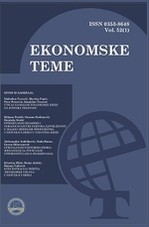Economic Themes (2024) 62 (4) 7, 541-560
Ivan D. Radojković, Ognjen V. Radović, Kristina R. Stevanović
Abstract: The purpose of this paper is to model and analyze the volatility of returns on investment units in voluntary pension funds in Serbia, focusing on five funds: Dunav, Generali Basic, Generali Index, DDOR Garant Ekvilibrio, and Raiffeisen Future. Given the growing significance of voluntary pension funds, the study explores the role of investment units as a crucial financial instrument that allows diversification and optimization of long-term returns. Methodologically, the study applies the Extreme Value Theory (EVT) using the Generalized Pareto Distribution (GPD) to model the extreme events in the distribution tails, a key component for risk management. The ARCH test was used initially to assess heteroskedasticity in the time series, but the absence of significant volatility changes negated the application of GARCH models. Instead, EVT was implemented to capture rare, yet impactful, fluctuations. Additionally, Value at Risk (VaR) and Expected Shortfall (ES) were estimated based on the fitted GPD model, offering more robust risk quantification for extreme losses. The results indicate that all return series are highly correlated, with extreme values predominantly occurring in shorter bursts. GPD models successfully captured these extremes, and VaR and ES measures highlighted the periods of elevated risk, particularly during financial crises. This research presents an original contribution to the analysis of investment unit volatility, providing practical insights for fund managers in balancing risk and return in a volatile market environment.
Keywords: Voluntary pension funds; Investment unit; Volatility; Extreme Value Theory (EVT); Generalized Pareto Distribution (GPD); Risk management
MODELING THE VOLATILITY OF RETURNS ON INVESTMENT UNITS OF VOLUNTARY PENSION FUNDS IN SERBIA
Ivan D. Radojković, Ognjen V. Radović, Kristina R. Stevanović
Abstract: The purpose of this paper is to model and analyze the volatility of returns on investment units in voluntary pension funds in Serbia, focusing on five funds: Dunav, Generali Basic, Generali Index, DDOR Garant Ekvilibrio, and Raiffeisen Future. Given the growing significance of voluntary pension funds, the study explores the role of investment units as a crucial financial instrument that allows diversification and optimization of long-term returns. Methodologically, the study applies the Extreme Value Theory (EVT) using the Generalized Pareto Distribution (GPD) to model the extreme events in the distribution tails, a key component for risk management. The ARCH test was used initially to assess heteroskedasticity in the time series, but the absence of significant volatility changes negated the application of GARCH models. Instead, EVT was implemented to capture rare, yet impactful, fluctuations. Additionally, Value at Risk (VaR) and Expected Shortfall (ES) were estimated based on the fitted GPD model, offering more robust risk quantification for extreme losses. The results indicate that all return series are highly correlated, with extreme values predominantly occurring in shorter bursts. GPD models successfully captured these extremes, and VaR and ES measures highlighted the periods of elevated risk, particularly during financial crises. This research presents an original contribution to the analysis of investment unit volatility, providing practical insights for fund managers in balancing risk and return in a volatile market environment.
Keywords: Voluntary pension funds; Investment unit; Volatility; Extreme Value Theory (EVT); Generalized Pareto Distribution (GPD); Risk management

